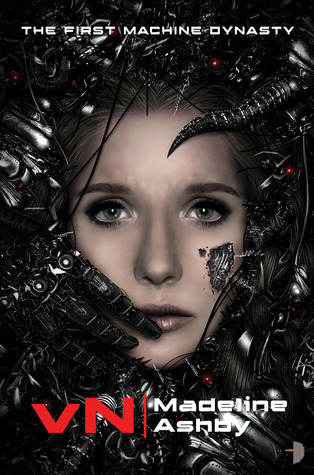Amy, the main character of Madeline Ashby’s debut novel vN, is a self-replicating humanoid robot. Her race was originally created in the hopes of protecting and serving the poor humans who would be left behind on Earth after the Second Coming. The Rapture has failed to materialize as the novel starts, so the growing number of vN (short for von Neumann machines) are slowly becoming part of humanity on a vastly changed Earth.
Amy is an example of some people’s desire to integrate the vN with regular, organic humans. This includes trying to bypass their usually rapid growth by slow-feeding them to simulate a regular, organic childhood. Because her human father and vN mother carefully ration Amy’s food to match her growth to the human children in her mixed school, Amy still looks like an actual five year old.
This careful planning is thrown off when Amy’s grandmother Portia suddenly shows up at a school event, attacking her mother. Possessed by the uncontrollable, built-in drive to feed and replicate, Amy ends up consuming her grandmother. Suddenly, Portia is a second personality inside Amy’s body, and Amy’s life will never be the same…
vN is, in many ways, an incredible debut novel. This should come as no surprise to readers who are familiar with Madeline Ashby’s short fiction or even her blog posts here on Tor.com. Still, it’s great to see that, despite a few quibbles, the long-awaited end result is this good. Kudos to Angry Robot (surely one of the most interesting current SF&F publishers) for picking up yet another interesting debut.
The most fascinating aspect of vN is the fact that it’s narrated by a non-human character whose driving forces were set in place by actual humans. As so often is the case with technology, the vN inventors didn’t properly predict how their creations would turn out. One of the strongest principles guiding vN is their “failsafe”: basic programming that ensures they cannot harm human beings or even passively stand by when a human is suffering. Yes, it’s a variation on Asimov’s laws of robotics, but now guiding humanoids who are stronger and more advanced but visually almost indistinguishable from humans. There’s even a need for special programming on TV, because just seeing the wrong violent action scene can set a vN into a helpless frenzy. The failsafe also places vN into some situations that are truly horrendous, even if they can’t realize that.
So what’s a mentally five year old vN (suddenly grown into an adult body) to do when she involuntarily commits a horrible act? She goes on the run from the hysterical authorities hunting for the “robot-gone-wild.” After the basic set-up of the prologue (seen from the perspective of Amy’s human father) and the opening chapters’ chaos, the novel essentially turns into a refugee travelogue, with Amy desperately trying to stay free and create a new life while making sense of her own recent actions.
In the course of the novel, she meets other vN and even takes a job in the Electric Sheep, a restaurant catering to both vN and humans. The establishment features dishes and drinks with names that will be meaningful to many SF fans, even if Amy doesn’t quite get cocktails called Tears in the Rain.
Amy encounters many friendly and less-than-friendly humans, and sees much more of the world than she ever bargained for. The story follows her as she experiences all the intellectual and emotional growth she missed during her artificially prolonged childhood: her eyes are opened to reality, and it isn’t always pretty. Be warned: even if the main character isn’t human, vN is sometimes a painfully brutal read.
If the novel has one weakness, it paradoxically derives from one of its main strengths: the novel is narrated by a vN. As fascinating as it is to read the thought processes and experiences of one of these humanoids, it’s sometimes also hard to connect with the character. You may get lulled into thinking that she’s a regular human, only to suddenly get yanked back to reality when she mentions she has to defrag rather than sleep. It occasionally feels as if the author got stuck between portraying Amy as a fully artificial being and a regular human. Of course, one of the main themes of the novel is exploring the tension between those two ideas, so if you look at it that way, it’s a huge success. Still, it’s hard not to feel that Ashby could have pushed the vN nature of her main character to further extremes throughout the novel.
What’s really fascinating about vN is the way it portrays a fairly complex future almost exclusively from the limited perspective of an immature and confused non-human character. There’s a future history hidden in these pages, but you have to glimpse it through eyes that can’t just can’t process all of it yet. You experience Amy’s growth while she learns the true nature of the world she somehow ended up in. Despite being a fairly fast-moving story, vN is not an easy novel to grasp on the first reading because it keeps changing direction and layering on ideas. It’s a deceptive read.
Androids aren’t anything new in SF, but Madeline Ashby gives the concept a surprising spin in vN. As a novel it may not be 100% perfect, but for a debut it offers more than enough depth and adventure to merit your attention. Check it out, and keep your eye on Madeline Ashby for the future.
Stefan Raets reads and reviews science fiction and fantasy whenever he isn’t distracted by less important things like eating and sleeping. His website is Far Beyond Reality.










